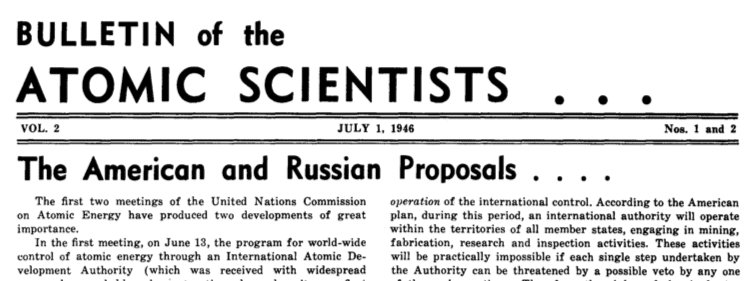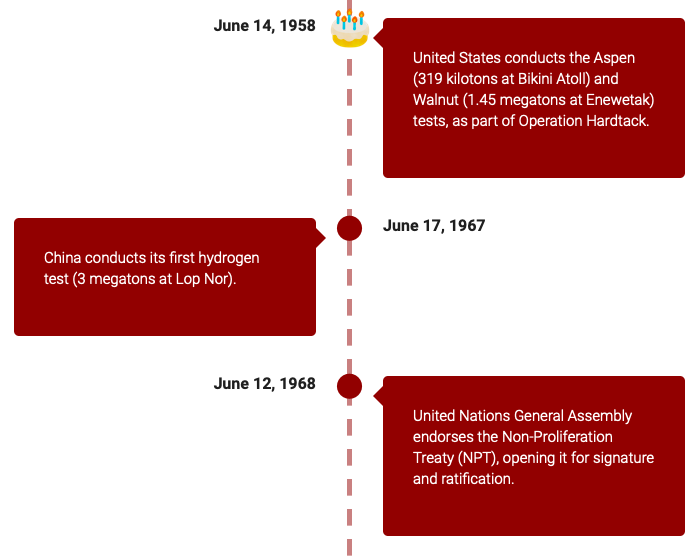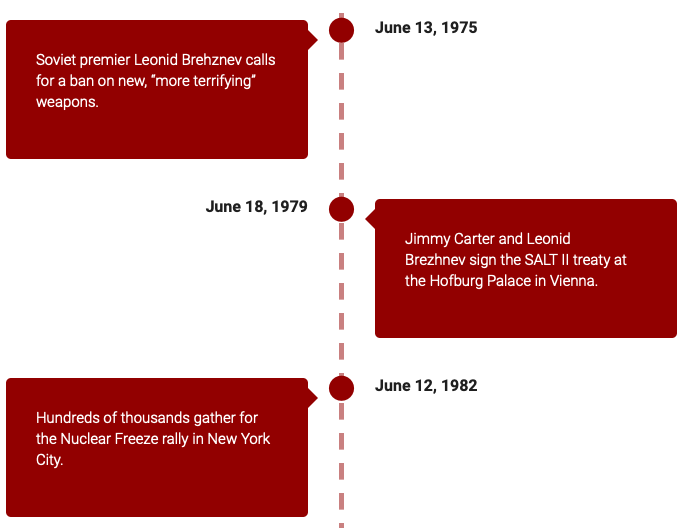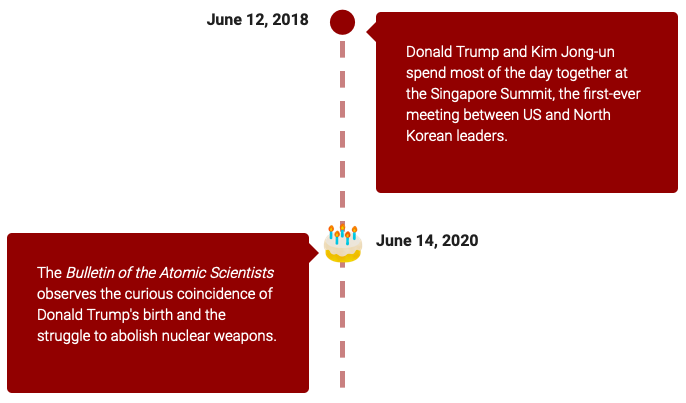Global Research, June 16, 2020
Bulletin of the Atomic Scientists 12 June 2020
The 45th president of the United States made his first international appearance on June 14, 1946. According to Donald Trump’s birth certificate, he was born at Jamaica Hospital in Queens, New York at 10:54 a.m.
Five minutes later, across town at Hunter College in the Bronx, UN Secretary General Trygve Lie called to order the inaugural meeting of the United Nations Atomic Energy Commission, established by the new UN General Assembly’s first (and understated) resolution “to deal with the problems raised by the discovery of atomic energy and other related matters.” Lie then gave the floor to the US representative, Bernard Baruch, who relayed a brief message from President Truman to the 12 members of the Commission: “Nothing concerns the whole world more than the achievement of the purpose that brings them together.”
Then Baruch presented the United States’ blueprint for taking everything related to nuclear energy, including its own weapons, out of the hands of sovereign states and placing it under international control.
“We are here to make a choice between the quick and the dead,” he began. “That is our business.”
The notion that the United States would volunteer to give up its entire nuclear arsenal sounds like science fiction, especially these days. In many ways, Bernard Baruch can be considered the antithesis of Donald Trump, even beyond his approach to international nuclear diplomacy. Baruch was a lifelong Democrat; Woodrow Wilson nicknamed him “Dr. Facts”; he was widely respected for his financial acumen; and he enjoyed talking about politics with people gathered near his favorite park bench in Washington D.C.’s Lafayette Park. There were some parallels too: A New York Times review of a Baruch biography suggested that “he knew better than any public figure of his time how to exploit the press’s need for news.”
But on June 14, 1946, as Trump continued to adjust to life outside the womb, Baruch continued his presentation to the Atomic Energy Commission. “The United States proposes the creation of an International Atomic Energy Development Authority,” he said, “to which should be entrusted all phases of the development and use of atomic energy, starting with the raw material.” This new authority would alone have “control of all potentially dangerous atomic activities” and full power to conduct inspections for violations.
Baruch detailed the terms, including:
When an adequate system for control of atomic energy, including the renunciation of the bomb as a weapon, has been agreed upon and put into effective operation and condign punishments set up for violations of the rules of control which are to be stigmatized as international crimes, we propose that:
- Manufacture of atomic bombs shall stop;
- Existing bombs shall be disposed of pursuant to the terms of the treaty, and
- the authority shall be in possession of full information as to the know-how for the production of atomic knowledge.
Let me repeat, so as to avoid misunderstanding: my country is ready to make its full contribution toward the end we seek, subject, of course, to our constitutional processes, and to an adequate system of control becoming fully effective, as we finally work it out.
More than seven decades later, it has not been worked out.
In the months before and after the June 1946 meeting, the recently launched Bulletin of the Atomic Scientists devoted many pages to discussion of the Baruch plan and the Acheson-Lilienthal report it was based on. An unsigned Bulletin editorial in the July issue stated: “We cannot afford to become angry or impatient, if other nations do not agree immediately with what we consider as a generous and equitable plan proposed in good faith. The establishment of an Atomic Energy Authority of the kind contemplated in the Baruch proposal is for us a matter of enlightened self-interest; we must bend all efforts towards persuading the USSR that it is equally a matter of enlightened self-interest for the Russians.”

A belated correction: The July 1, 1946 edition of the Bulletin identified the date of the first United Nations Atomic Energy Commission meeting as June 13. The date was June 14.
When the Baruch plan finally came up for a vote at the end of 1946, the Soviet Union abstained, guaranteeing that it would not be approved in the Security Council (where the Soviets had the veto). The underlying cause of the plan’s demise is a matter of some debate. The Soviets were concerned that the United States would take advantage of its stature at the United Nations to simply maintain its monopoly on atomic weapons. Another view is that the Soviet Union would not accept the robust inspection regime that was at the core of Baruch’s scheme. The US proposal to discard the veto power on nuclear-related issues may have been an intentional wrench in the works that the Soviet Union opposed. The truth is likely all of the above, and historians argue that neither Truman nor Stalin were particularly enthusiastic to begin with (cables published and translated online this month from the Russian State Archive reveal some of the deliberation that went on between New York and Moscow at the time).
The arms race dynamic took hold. US presidents publicly advocated for nuclear disarmament at various points throughout the Cold War (a term first used in the US-Soviet context by Baruch himself), but the Baruch plan was as near as a major nuclear power has come to relinquishing its warheads. In 1951—when Donald Trump was five years old and still living in Queens, just down the street from the United Nations’ temporary offices in Lake Success—Truman gave a radio address ostensibly intended to rekindle elements of the original plan, but at the same time he continued to point the finger at the Soviet Union:
“It is true that we have met rebuffs and refusals from the Soviet government, ever since the day we offered to give up our monopoly of atomic weapons and to prohibit them under a system of International control. Nevertheless, as responsible men and women, we must try for disarmament in spite of all difficulties. We cannot permit the history of our times to record that we failed by default.”
At age 15, Trump might have tuned in again as his future predecessor John F. Kennedy renewed a call for disarmament during his September 1961 address to the United Nations.
“We far prefer world law, in the age of self-determination, to world war, in the age of mass extermination,” Kennedy said. “The weapons of war must be abolished before they abolish us… And men may no longer pretend that the quest for disarmament is a sign of weakness–for in a spiraling arms race, a nation’s security may well be shrinking even as its arms increase.”
But by the time Donald Trump was old enough not to drink, the United States nuclear arsenal had neared its 1966 peak of more than 31,000 warheads.
Over the next several decades, disarmament efforts were outshined by bilateral arms control and non-proliferation agreements as the primary achievements of nuclear diplomacy. From the 1970 Nonproliferation Treaty to the 1972 Anti-Ballistic Missile and 1987 INF treaties, and from SALT I and II to START and then New START, limits on nuclear weapons have been far more successful than attempts to eliminate them altogether. But nuclear weapons have never been controlled in the ways first proposed by the members of the UN Atomic Energy Commission.
When the Baruch plan turned 40 in 1986, so did Trump. Around that time he reportedly met with another Bernard, Bernard Lown—founder of International Physicians for the Prevention of Nuclear War, which won the 1985 Nobel Peace Prize. According to Lown, Trump wanted his help connecting with Mikhail Gorbachev so he could become Ronald Reagan’s indispensable nuclear negotiator.
“[Trump] said he would go to Moscow and he’d sit down with Gorbachev,” Lown told the Hollywood Reporter. “And then he took his thumb and he hit the desk and he said, ‘And within one hour the Cold War would be over!’ I sat there dumbfounded. ‘Who is this self-inflated individual? Is he sane or what?'”
Later that year Gorbachev and Reagan famously contemplated ridding the world of nuclear weapons once and for all at their summit in Reykjavik—but contemplation is as far as it got. Those discussions did, however, give the ambitious goal of total disarmament a new lease on life.
Few could have predicted then that New York’s most notorious real-estate developer would eventually occupy Reagan’s seat and become the world’s most effective nuclear deal breaker. Under Trump’s watch, the United States has subverted most of the major nuclear agreements of the past four decades, beginning with the Iran deal (signed by former secretary of state John Kerry on Trump’s birthday in 2015), the Intermediate Nuclear Forces (INF) treaty, and the Open Skies treaty. The New START treaty that limits and provides for inspection of US and Russian nuclear warheads is on its final lap, while the White House gestures toward unlikely new trilateral agreements and mulls resuming nuclear tests.
In fact, Trump has moved in the opposite direction, urging massive expenditures for modernization of the nuclear arsenal and potentially unnecessary plutonium pit production. The 2018 Nuclear Posture Review expanded the possibility of nuclear weapons being used to respond to non-nuclear attacks, and opened up a new era of warhead development that led to the deployment late last year of so-called “low-yield” nuclear-tipped missiles on submarines—each with explosive power only marginally less than the bombs dropped on Hiroshima and Nagasaki a few weeks before Trump was conceived. Born together with the beginnings of international disarmament, he has become one of its greatest enemies, ignoring experts and surrounding himself with opponents of international agreements.
Now, nations of the world are learning to move on as best they can absent the interests outlined by the United States in 1946. The text of the Treaty on the Prohibition of Nuclear Weapons was agreed to by 122 countries in 2017, at the second session of the UN Conference to Negotiate a Legally Binding Instrument to Prohibit Nuclear Weapons, Leading Towards their Total Elimination (which began the day after Trump’s 71st birthday). Last week, Lesotho became the 38th country to ratify the treaty, which will enter into force with 12 more ratifications. 81 states have signed. Although the nine nuclear states show no intention of joining in, the “paper victory” is still seen by the treaty’s proponents as a critical step forward in the long delayed project of eliminating nuclear weapons for good.
Donald Trump turns 74 this Sunday, just a few days before he appears set to ignore the pandemic and take his 2020 reelection campaign back out on the road. While the president may lack similar enthusiasm for international nuclear disarmament, the effort has lasted as many years as he has, ever since Baruch first left his “bench of inspiration” to address the UN in 1946.
***
A timeline of nuclear events on (or around) Donald Trump’s birthday on June 14
*
Note to readers: please click the share buttons above or below. Forward this article to your email lists. Crosspost on your blog site, internet forums. etc.
Thomas Gaulkin is multimedia editor of the Bulletin of the Atomic Scientists. Prior to joining the Bulletin in 2018, he spent the previous decade working in communications at the University of Chicago, first with the centers for International Studies and International Social Science Research, and later as director of News and Online Content for the Division of the Social Sciences. From 1999-2002 and again in 2006 Gaulkin produced Worldview, Chicago Public Radio’s daily global affairs program.
Featured image is by Thomas Gaulkin. (National Museum of the US Air Force photo by Kelly Michals/CC-BY-NC)
The original source of this article is Bulletin of the Atomic Scientists
Copyright © Thomas Gaulkin, Bulletin of the Atomic Scientists, 2020
https://www.globalresearch.ca/curious-coincidence-birth-donald-trump-struggle-abolish-nuclear-weapons/5716085
Counter Information published this article following the Creative Commons rule. If you don't want your article to appear in this blog email me and I will remove it asap.



























No comments:
Post a Comment